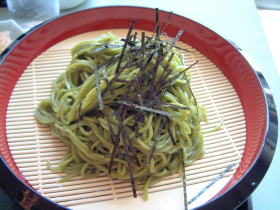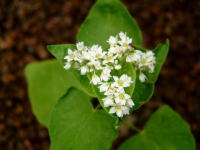 |
 |
| zaru-soba | cha-soba |
soba
 |
 |
| zaru-soba | cha-soba |
Soba is very popular typical Japanese noodle made from buckwheat flour,
wheat flour, yam starch and egg white serving, which is used as a thickener.
The cour of soba is usually pale brown (Udon is white and thicker) and
cha-soba is added tea powder.
We found buckwheat seeds in the excavations of B.C.900-500
It is said that cultuvation of soba was started at least approximately
3,000 years ago.
In 722, the Nara period, the Emperor encourage to produce buckwheat
because even in poor soil, it grows very good.
So, especially in mountainsides it was a very valuable food.
At that time we didn't know the technique of liaison, so the way of cooking
might be very simple
...just make powder, then make paste and boil or bake ?
It is said that soba noodles were made approximatelly 400 years ago.

SOBA
It is not impolite to make noises while we eat soba.
There are probably two reasons.
First, soba will get soft if you leave it,
so it is acceptable to sulurp noodles and eat fast.
Secondly, soba has a light good smell,
so if you eat it in the air, you can
feel it in your mouse.
(the top picture)
Boiled soba is frequently served cold, topped with
pieces of the dried seaweed, nori.
It is usually served on a slatted bamboo drainer (zaru)
like a picture below, with cold dipping sauce.
Minced leek and horseradish are used as condiments.
zaru-toro is cold soba with grated yam.

We call soba ,that is hot and plane, kakesoba.
This is made by putting boiled soba in a hot, soy flavored broth,
and add steamed fish paste and boiled spinach.
If you put any other toppings, it changes its name.
For example
tempura-soba with shrimp tempura
tanuki-soba with fried tempura batter
nishin-soba with simmered sweet soy-taste herring
tsukimi-soba with a raw egg
sansai-soba with edible wild plants
kitsune-soba with sweet deep-fried bean cured
On New Year's Eve, soba,called toshi-koshi-soba, is eaten in many houses.
First, because it's a symbol of longevity, as soba is long noodle.
Second, in hope to be rich, because soba was used to collect
waste of gold among gold craftmen.
Third, in hopes of warding off bad luck, because pure soba is liable to
be cut.
Fourth, in hopes of being healthy, as soba contains rutin (a kind of flavonoid),
it protects capillary getting weak, and
is effective in preventing cerebral hemorrhage or high blood pressure or
any other vascular problem.
Rutin is aqueous, so drink "sobayu", water boiled soba.
As old customs such as this are fading,
but when Japanese people move we take soba
to our new neighbors wishing to keep a long relationship, like soba.
![]()